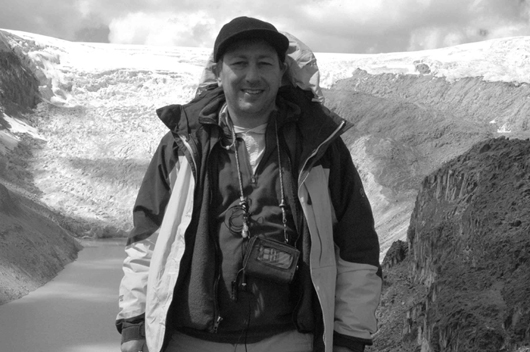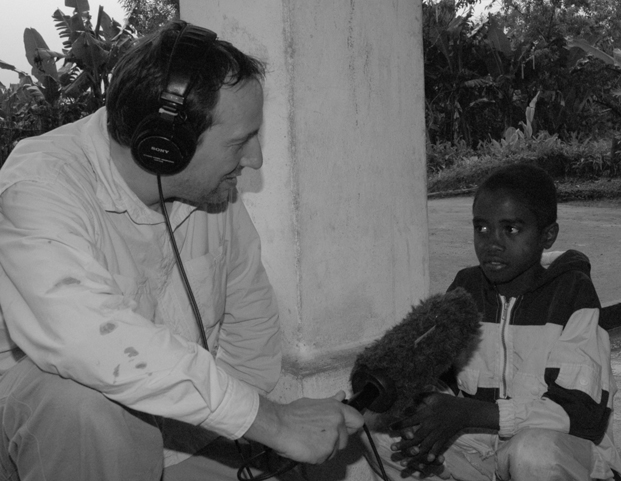Lecture: Dan Grossman

Dan Grossman at the Quelccaya Ice Cap in the Andes mountains of Peru. Photo courtesy of Dan Grossman.
RELATED:
Dan Grossman finds at least three angles for every multimedia science story he produces, capturing everything from the sounds of glaciers breaking in Greenland to images of extinct reptiles in Madagascar.
“I wear three hats: radio, Web, and video,” he told NYU journalism students in a lecture about the challenges of multimedia freelancing on April 17, 2007. He said his work is a blend of thoughtful planning, happenstance, and vision.
Between 2002 and 2004, Grossman planned three major trips for WBUR, Boston’s National Public Radio station — to Antarctica, Greenland, and Madagascar. He created stories from his travels through sound, writing, video, and still photography. WBUR went beyond the traditional radio format and featured separate, but related stories on their website. “It is cutting edge for a station to produce its own web content that is much more than what’s on the radio,” Grossman said of WBUR’s website.
"I try never to do one product with my material. As a freelancer it seems a necessity...to multipurpose your material."
After he arrives on location, Grossman said he often stumbles across stories by chance. For example, while in Antarctica he met Donna Patterson, a scientist researching Antarctic scavenger birds called giant petrels. “This is a serendipity thing,” he said. “I decided on the fly that we would have her do some write ups of the different nests.” In the end, Patterson’s diary appeared on WBUR’s website. In one entry, Patterson noted about one of the birds, “Nest one male is exceptionally calm, good natured, and a delight to have in our study area.” In another diary entry, she wrote that she'd nicknamed one giant petrel Norman Bates.
Grossman's voyage to Greenland illustrated the lengths he will go to in order to capture material. A radio program told him they had already heard sounds of ice cores and wanted something new. In search of new sounds, Grossman spent $3,000 to charter a boat so he could record sounds of glaciers breaking up, or calving.
In Madagascar, Grossman worked with Steve Goodman, a biodiversity expert who is studying the creatures that inhabit the island. “Some of the species were extinct by the time they were described,” Grossman said. For WBUR’s website, he recorded the calling and scuffling of creatures in the island’s forests and then created a gallery of animal sounds. That project, Grossman told students, was easier to conceive than to execute. After returning to the U.S., he faced the challenge of organizing his film footage, audio recordings, and photos. “There are 500 captioned pictures on the website,” he said. “There are many hours of sound and more than a dozen videos. This took me months to process this material.”
To fund his trip to Madagascar, Grossman looked to an environmental organization. “I started poking around and found the Critical Ecosystem Partnership Fund, which uses money to help protect ecosystems around the world,” he said. “I told them I wanted to do a website that would be helpful in preserving biodiversity in Madagascar.”
For his trip to Antarctica, Grossman applied to the National Science Foundation and was accepted. "Several journalists each year are invited by the National Science Foundation," he said. "You have to apply, and it's very competitive."

Dan Grossman in Madagascar. Photo courtesy of Dan Grossman.
Because WBUR recently lost much of its funding, Grossman has begun to sell his multimedia presentations to other media outlets, like the National Geographic Magazine website. Grossman is also planning to approach individual radio stations, rather than nationally broadcast shows, about airing his work. "In radio, you don't have to sell to a program, you can sell to a station," he said. "There are several hundred in the country, and you can market directly to them." He also sells his stories internationally to Radio Netherlands, the Canadian Broadcasting Corporation, and the Australian Broadcasting Corporation.
This multi-pronged strategy is the key to his professional survival in a competitive broadcast market. "To make ends meet [as a freelancer], I have to be more creative about using my material than others that don’t have to try as hard.” Grossman said. "I try never to do one product with my material. As a freelancer it seems a necessity...to multipurpose your material."

